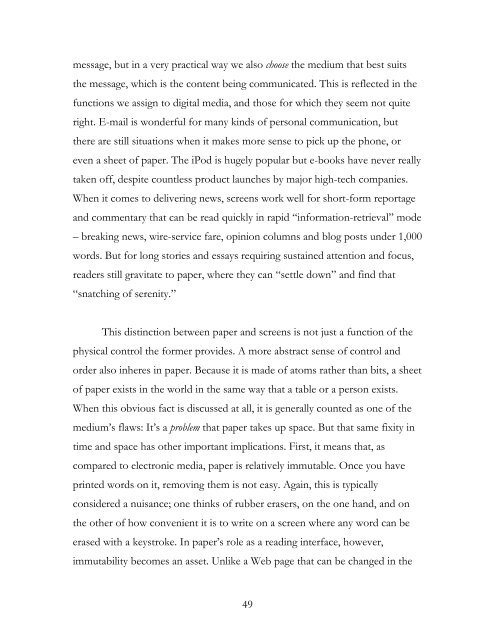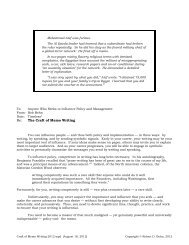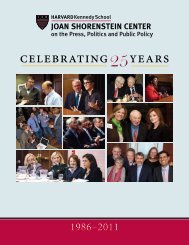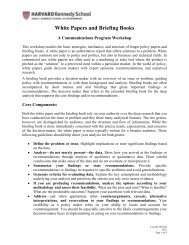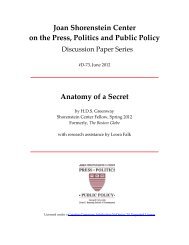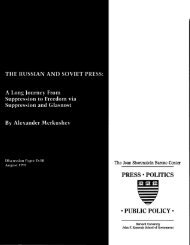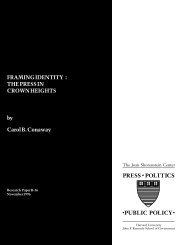Why Paper Is Eternal - Joan Shorenstein Center on the Press ...
Why Paper Is Eternal - Joan Shorenstein Center on the Press ...
Why Paper Is Eternal - Joan Shorenstein Center on the Press ...
You also want an ePaper? Increase the reach of your titles
YUMPU automatically turns print PDFs into web optimized ePapers that Google loves.
message, but in a very practical way we also choose <strong>the</strong> medium that best suits<br />
<strong>the</strong> message, which is <strong>the</strong> c<strong>on</strong>tent being communicated. This is reflected in <strong>the</strong><br />
functi<strong>on</strong>s we assign to digital media, and those for which <strong>the</strong>y seem not quite<br />
right. E-mail is w<strong>on</strong>derful for many kinds of pers<strong>on</strong>al communicati<strong>on</strong>, but<br />
<strong>the</strong>re are still situati<strong>on</strong>s when it makes more sense to pick up <strong>the</strong> ph<strong>on</strong>e, or<br />
even a sheet of paper. The iPod is hugely popular but e-books have never really<br />
taken off, despite countless product launches by major high-tech companies.<br />
When it comes to delivering news, screens work well for short-form reportage<br />
and commentary that can be read quickly in rapid “informati<strong>on</strong>-retrieval” mode<br />
– breaking news, wire-service fare, opini<strong>on</strong> columns and blog posts under 1,000<br />
words. But for l<strong>on</strong>g stories and essays requiring sustained attenti<strong>on</strong> and focus,<br />
readers still gravitate to paper, where <strong>the</strong>y can “settle down” and find that<br />
“snatching of serenity.”<br />
This distincti<strong>on</strong> between paper and screens is not just a functi<strong>on</strong> of <strong>the</strong><br />
physical c<strong>on</strong>trol <strong>the</strong> former provides. A more abstract sense of c<strong>on</strong>trol and<br />
order also inheres in paper. Because it is made of atoms ra<strong>the</strong>r than bits, a sheet<br />
of paper exists in <strong>the</strong> world in <strong>the</strong> same way that a table or a pers<strong>on</strong> exists.<br />
When this obvious fact is discussed at all, it is generally counted as <strong>on</strong>e of <strong>the</strong><br />
medium’s flaws: It’s a problem that paper takes up space. But that same fixity in<br />
time and space has o<strong>the</strong>r important implicati<strong>on</strong>s. First, it means that, as<br />
compared to electr<strong>on</strong>ic media, paper is relatively immutable. Once you have<br />
printed words <strong>on</strong> it, removing <strong>the</strong>m is not easy. Again, this is typically<br />
c<strong>on</strong>sidered a nuisance; <strong>on</strong>e thinks of rubber erasers, <strong>on</strong> <strong>the</strong> <strong>on</strong>e hand, and <strong>on</strong><br />
<strong>the</strong> o<strong>the</strong>r of how c<strong>on</strong>venient it is to write <strong>on</strong> a screen where any word can be<br />
erased with a keystroke. In paper’s role as a reading interface, however,<br />
immutability becomes an asset. Unlike a Web page that can be changed in <strong>the</strong><br />
49


